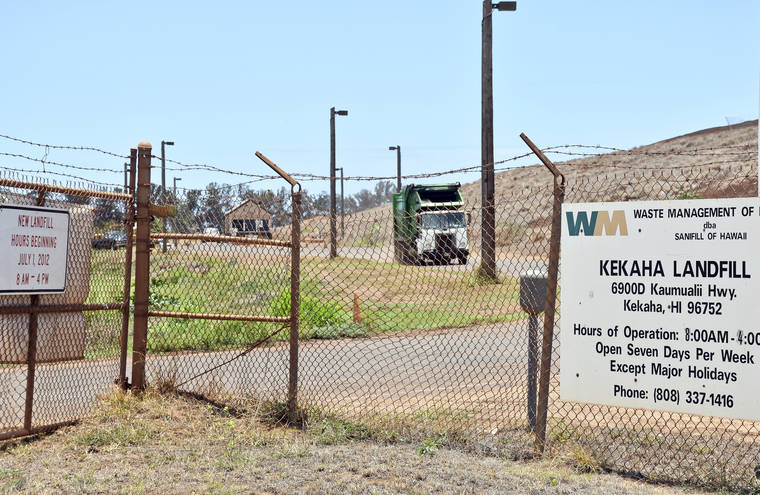LIHU‘E — The county Deparatment of Public Works Solid Waste Division had a total overtime budget of $227,000 in fiscal year 2020.
According to the SWD, the department calculated $469,902.39 of overtime last year, most attributed to landfill operations, administration, transfer stations and refuse collections, said Acting Solid Waste Chief Allison Fraley, who briefed the Kaua‘i County Council on Wednesday with Acting County Engineer Troy Tanigawa.
The county Department of Human Resources calculated that, for the period between July 1, 2019 to May 15, 2020, the division totaled $367,549.20 in overtime. That would mean SWD employees earned $102,353.19 in overtime the last 45 days of the county’s fiscal year, not including paid time off.
In fiscal year 2019, overtime totaled $344,667.85, up from 2018 when it totaled $297,588.48. Unbudgeted overtime was covered by savings and vacant positions, Fraley said.
Including compensatory time, like vacation and sick days, the department has a time reflect of $582,452.36 in that 10-and-a-half-month time period of 2019 to 2020. At the end of last fiscal year, SWD reported an additional $184,895.63 for the division’s overall year, which includes paid out comp time that has not been paid out, according to a county’s spokesperson.
The lowest overtime paid was $1.59, the highest $35,988, according to HR calculations. Three other employees ranging from a landfill operator to a program developer coordinator to a solid waste worker all made upwards of $10,000 in overtime.
Fraley briefed the council on overtime as it relates to operations of the Kekaha Landfill and refuse-transfer stations, refuse collections, program management and administrative functions, as requested by Vice Chair Ross Kagawa.
Overtime use within the department has been a decade-long discussion.
In March 2011, division’s workers made $12,237 on average in overtime during FY2010, which started July 1, 2009. Two employees made almost $40,000 each in overtime during that period, according to a story in The Garden Island from the time.
An overtime increase in FY20 was the result of a vacancy of a division chief, a leave of absence of a management position, the loss of a project manager and hiring freeze, Fraley reported.
The landfill, as well as refuse-transfer stations in Hanalei, Kapa‘a, Lihu‘e and Hanapepe, operate seven days a week.
The primary issue is that there is a minimum workforce requirement for the landfill and refuse stations to operate. The staffing shortages are the main cause of overtime.
On weekdays, the landfill needs nine crew members plus one supervisor, and on weekends a seven-person crew plus supervisor to operate. The refuse stations need between two and three crew members plus one worksite supervisor.
Fraley offered potential solutions for cutting overtime, like shortening the workweek, reducing hours of operations, reducing consultation calls and following up on sick-leave abuse. Fraley said SWD is conducting a study to see when the stations are most active.
Last year, the county took over operations of the Kekaha Landfill from the previous manager, Waste Management Hawai‘i, due to a contractual dispute. The most overtime was made by the county’s landfill worksite supervisor.
Councilmember Felicia Cowden has visited the refuse stations and seen the longstanding broken-down machines and fences that have been broken for over a year.
Kagawa pointed to low morale within the department.
“I have gotten numerous complaints from employees who feel that they suffer from the lack of fairness in distributing overtime,” he said. “Frankly, I’m a little bit disappointed. (There are) a lot of excuses and lack of accountability to what is going on.”
Tanigawa addressed these concerns directly, stating that the union contract requires the department to ask all employees interested in overtime to fill out a list of available times, and then they are called on a rotational basis that works for them.
Five months ago, payroll records were reviewed, and changes implemented to what constituted overtime work. After three months, the overtime was seen to decrease 10% on top overtime-earning employees, Tanigawa said.
“Monitoring and controlling the overtime are essential to managing operational costs,” Tanigawa said. “Overtime work should be limited to the completion of only those tasks required to be essential.”
Councilmember Luke Evslin requested a breakdown of overtime to see where overtime was specifically occurring.
“Show us the numbers, and maybe I’ll believe it more,” Councilmember KipuKai Kuali‘i said.
•••
Sabrina Bodon, public safety and government reporter, can be reached at 245-0441 or sbodon@thegardenisland.com.



It’s not staffing shortages that bloat the OT- it’s union rules related to vacations, time off and sick leave that bankrupt this county and state….